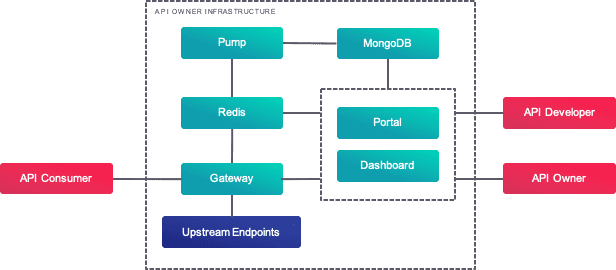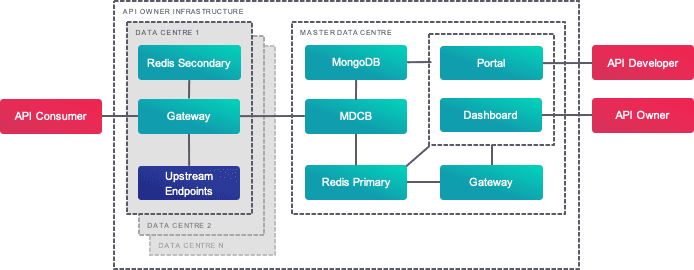Are you considering moving your API Management across multiple data centres? There are certainly many reasons why you might do so. If this is where you’re heading, then Tyk’s Multi Data Centre Bridge (MDCB) is here to make your migration as seamless as possible.
Taking advantage of Tyk’s Multi Data Centre Bridge can help manage your Tyk API gateway SaaS instances effectively and efficiently. Some of the more common scenarios that benefit from MDCB usage include:
- distributing services across multiple regions
- wanting to ensure redundancy by using multiple data centres (i.e. if one data centre goes down, traffic will be routed to your other data centre)
- migrating to a new cloud provider or having services in more than one cloud provider
- needing to adhere to local compliance laws by making sure data remains within its originating region
What is MDCB?
The Tyk Multi Data Centre Bridge allows you to centrally manage your Tyk Gateway clusters. This essentially leads to a “single pane of glass” or control plane for all gateway instances. This has many advantages over having separate gateways and corresponding dashboard/portals, which would require synchronisation to roll out any changes across all the individual gateways.
MDCB simply aims to make life easier for those running gateway instances out of multiple data centres.
The benefits of MDCB
MDCB can benefit organisations running gateways out of multiple data centres in many ways.
Better uptime
If there is downtime within your Master Data Centre, gateways that are still up and running can manage the traffic flow until the Master Data Centre comes back up, without any recourse. Once the Master is restored, all gateways will hot-reload any new configurations and resume normal operations.
Latency reduction
When using MDCB, all operations are geographically localized. This massively reduces round trip time, which squashes any concerns around latency.
Single dashboard for multiple gateways
All gateways report into a single dashboard and portal, allowing for consistency across the organization. Within MDCB you have the ability to segment out teams with their own gateways and sub-segment those gateways even further with tagging.
The architecture of MDCB
The use of the Tyk Gateway in a single data centre will be structured as follows:
This setup includes a gateway with its own portal and dashboard, as well as a single Redis cluster, Pump and Mongo instance. In a single installation of Tyk, this model works very well. However, when moving into multiple data centres, the complexity quickly increases. This means support and configuration changes become very process-driven, including ensuring that each instance is kept up-to-date on an individual basis.
The use of MDCB eliminates the above pain points. It does so by centralising the dashboard that all deployed gateways will use for configuration changes and reporting analytics to. Moving into multiple data centres and leveraging MDCB would now look like this:
The updated architecture now utilises multiple data centres. You’ll notice that each gateway is deployed in a data centre with its own local Redis data store (denoted as Redis Secondary) and establishes a connection to the MDCB component in the Master Data Centre.
The Master Data Centre now becomes the control plane to drive configuration management and analytics storage in one centralised location for all gateway instances. This is achieved through the use of Mongo and Redis (denoted as Redis Primary**) within the Master Data Centre. The portal and dashboard now have a connection to all gateways across all data centres. This leads to a “single pane of glass” approach to config, analytics and other features that the Tyk dashboard and portal offers.
Migrating to MDCB
Installing and migrating over to MDCB is actually quite simple and can be built off your existing data centre instance. The first step is to talk to a Tyk Account Manager to get access to this feature, which requires a licence to use. Once you have acquired a licence, you simply need to:
- Install MDCB in your current data centre and point to your existing Redis and MongoDB instances. Convert your existing gateway installation(s) into management gateway(s). This will now become your Master Data Centre.
- In your new and existing data centres, bring up and configure your gateways and supporting Redis infrastructure.
- Lastly, point each of your new gateways to your MDCB component in your Master Data Centre.
If you’d like more information on setting up your MDCB configuration check out our documentation.

